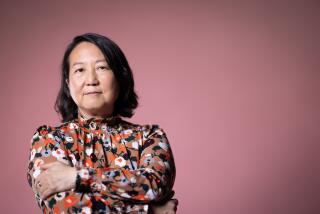Fighting to End a Korean Stereotype
When Marcia Choo became director of the Asian Pacific American Dispute Resolution Center two years ago, she thought she would be raising money and winning support for the small organization that helps people resolve conflicts--landlord-tenant disputes, delinquent bills--outside of court.
But after the recent riots and the shooting death of Latasha Harlins by a Korean-American merchant more than a year ago, she has been grappling with volatile race relations and crossing different languages and cultures.
Choo, 27, has given countless talks on Korean immigrant culture, visited storekeepers in the Korean community to ask them about their concerns and trained volunteers.
In a joint effort with the Martin Luther King Jr. Dispute Resolution Center, she is seeking to appoint an African-American and a Korean-American to work full time on tensions between the communities.
âThereâs a lot of ethnocentrism from the Korean, African-American and Latino communities right now,â Choo said. âI see a lot of people finger-pointing and thatâs all across the board. We do acknowledge that pain is very real and that thereâs a lot of residual anger. But we need to sit down and identify how we move on.â
The recent moratorium on liquor stores imposed by the city Planning Commission is a perfect place to start, she said. âThere are businesses that want to rebuild. We want to believe the needs of the community and businesses arenât mutually exclusive. Iâm not advocating that liquor stores come back, but you have to give viable alternatives and opportunities.â
Dennis Westbrook, project director for the Martin Luther King Jr. Dispute Resolution Center, has worked closely with Choo and says: âShe has a voice of moderation but raises issues that have not been raised. . . . Because of her knowledge of dispute resolution concerns and how it relates to intercultural relations, she has been pressed into a position of a powerful and effective voice.â
Choo has worked with a wide range of organizations. While pursuing her social psychology degree at UCLA, she worked for a public affairs consulting group that counseled gay and lesbian organizations, AIDS hospices and the American Indian Free Clinic. After serving nearly a year on the City Focus fellowship, sponsored by the Coro Foundation, she assumed her current position.
Choo, who immigrated with her family from Korea at the age of 5, credits her parents for supporting her ambitions. She speaks proudly about her college-educated mother, who worked in a garment factory in the United States, and her father, who earned a law degree in Korea but worked in a boat factory here.
âWhen people (hear) me speak without an accent, they think that we have achieved the American dream. But they donât see under the layers. They donât see the painful experiences we live with. Those stories never get told. Because we donât speak English, we are largely invisible and voiceless.â
Choo is enraged that the stereotype of a rude merchant has come to characterize the Korean-American community: âWe have the largest Korean population outside of Korea, yet we continue to be defined by rude Korean merchants, who are a very small portion of our community. There is no balance. We have very little exposure in the mainstream media.â
As a member of the Black-Korean Alliance, created by the county Human Relations Commission after four Korean-American merchants were killed in April, 1986, Choo has dealt directly with the conflicts between Korean-American and African-American communities.
And she hopes that the riots will offer an opportunity to take a fresh look at the deeper, underlying problems. She wants to create neighborhood councils to discuss local issues, expand cultural awareness and develop basic mediation skills.
âIâm not naive enough to think that mediation is going to solve everything,â she says, âbut trying to mediate can bring people together and moving toward one direction. Itâs not the solution, just the contribution to the whole.â
More to Read
Get the L.A. Times Politics newsletter
Deeply reported insights into legislation, politics and policy from Sacramento, Washington and beyond. In your inbox three times per week.
You may occasionally receive promotional content from the Los Angeles Times.










